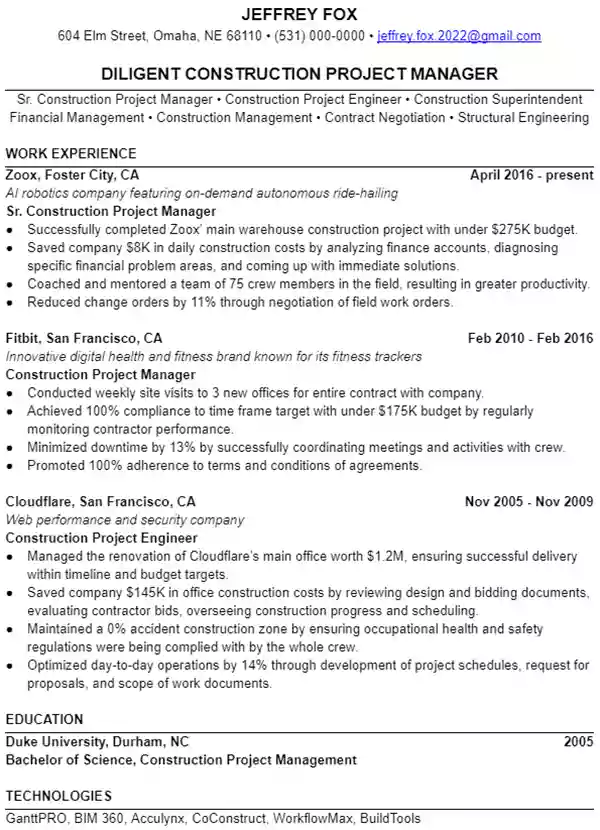Construction Resume Example
Write a great construction resume to get more job offers and job interviews by following our no-nonsense resume writing guide. Or, hire us to write your construction resume for you for free.


How to write a great Construction resume
No matter what job you hold in the construction field – or what job you want to get – you can’t get started without a great construction resume.
But how do you write a great Construction Resume? How do you need to format your resume?
Is there a certain order you should list your experiences in (hint: yes there is)?
If so, what is it?
We want to help you write the best construction resume possible. That’s why we created this great construction resume template which shows you how you’ll need to format your resume.
Interested in learning how to write your own resume?
Read on to find out more!
Why is my Construction resume so important?
“Do I really need a resume?”
“Can’t I just get a job through my connections?”
Yes, you can get a job through your connections, but those connections are going to first say, “send me your resume.”
And if you’re out of luck in the connections department, you’re absolutely going to need to use your resume as your foot in the door.
Here’s a stunning stat: for every construction job posted to a job board, 118 people will apply.
That’s 118 resumes for a hiring manager to sift through while they’re managing ten other tasks at the same time.
You need a resume that clearly highlights your qualifications, catches your recruiter’s attention, and gets you moved forward to that critical stage: the interview.
With so much riding on a successful resume, you may want to consider hiring an expert.
You may want to consider hiring us.
At Leet Resumes, we’ll write your construction resume for free – tips encouraged for a job well done!
Click here to get started today!
How do I format my Construction resume?
If you’re ready to write your resume on your own, at least let me teach you the proper way to format it.
Remember when I said that 118 different people apply for each job?
Well, hiring managers use special software to cut this number down to a reasonable amount.
This software, called ATS, tries to weed out unqualified resumes. It looks for experiences, key skills, and other buzzwords.
It also is very easily confused.
If you use funky formatting like pictures, text boxes, or multiple columns, it has a hard time reading your resume. It’ll end up putting your experience in your education section, or something even worse.
The end result is that your resume won’t get a fair score, and you’ll be unlikely to get an interview.
This is why we strongly suggest that you follow our no-nonsense resume format.
You’ll format your resume in this manner:
- Name + Contact
- Professional Headline
- Professional Summary
- Work Experience
- Keywords
Let’s take a look at each of these categories in greater detail.
Name + Contact
This may sound a little obvious, but you need to put your name at the top of your resume.
Otherwise, how else is the hiring manager going to know who you are?
Once you’ve taken care of your name, you’ll need to put your contact information below it.
For your contact information, all you’ll need are your phone number and your email address.
For your email address, make sure it sounds professional. 70+ percent of recruiters would throw out a resume for a red flag such as an unprofessional email address, so don’t give them the opportunity to toss your resume in the trash.
You can optionally add your LinkedIn account, but we don’t find this to be necessary. We’d rather save the space for the important stuff, like your work experience.
Professional Headline
This may seem surprising, but the next thing on your resume needs to be your headline.
It’s a bit like your job title, except you get to pick it out for yourself.
You need to use 3-5 words to come up with the job title you are currently seeking, your seniority level, and your work style.
Here’s a sample professional headline that you can get started with: Dedicated Senior Construction Manager
Nice. This shows that you can manage a team, that you’re committed to your job, and that you work in construction – all things the hiring manager needs to know.
Professional Summary
Where the professional headline is brief, the professional summary dives a little deeper – but not too deep.
Instead, this is more like a little mini-version of your resume. You use 2-4 lines to show a hiring manager what job you’re seeking and why you’re qualified for that job.
Here’s the format you’ll use.
- Job titles you’re seeking
- Construction skills you possess
- Relevant achievements in the construction field
- Awards and Promotions
Lines one and two are mandatory, while lines three and four are dependent upon your experience. If you’ve been in construction for a while, you should feel free to flesh out those last two lines.
If this is your first job, then you should probably stick to lines one and two.
Work Experience
This is the beating heart of your construction resume.
Remember when I mentioned that there was a certain order for your work experience?
Here’s where I’ll tell you: reverse chronological order. Start with your most recent job, and work your way back. This is how hiring managers and recruiters are trained to read a resume, so they’ll expect yours to fit that format.
Don’t disappoint them.
For the bullets under each work experience (always use bullets, don’t bother with paragraphs), you’ll want to keep these five tenets in mind.
Focus on successes, achievements, and accomplishments
This is the key to a strong construction resume. You don’t want to focus on your daily job duties. You want to focus on your big wins. You want to show your recruiter what you’re able to bring to a company – and get them to imagine what great projects you’ll complete once they hire you.
Start with a strong verb
This goes hand in hand with the big wins. Use a strong verb (built, constructed, managed, designed) to show that you are an active, not passive, professional.
It will completely flip the dynamic of your resume, and lead to an increase in interviews.
Quantify your experience
Wherever possible, add numbers to quantify your experience. Instead of saying you managed a team, say you managed a team of three.
Quantifying your experience will show off the specific impact you’ve had at an organization, which will help a hiring manager see how impressive your candidacy is.
Include your promotions
Definitely include your promotions if you’ve been promoted. This shows that you can learn and grow on the job, which hiring managers value. They’ll subconsciously see that they’re hiring you for this job and a possible future promotion – increasing the chances you’ll get that interview.
Don’t forget dates
Last but not least, do not forget to include dates – even if you’ve had some resume gaps. Resume gaps are not that big of a deal, and any interviewer will give you the chance to explain why you took some time between positions.
Omitting dates, on the other hand, seems shady. It makes it look like you have something to hide. Hiring managers are less likely to call you up for an interview if they think you aren’t being honest.
Education
This section is simple. All you need is to list any degrees or certificates you’ve completed, along with the institution you attended.
If you’re still attending a program, it’s best to leave it off the resume, unless your anticipated graduation date is within the next couple of months. In that case, make sure you note the anticipated graduation date.
Keywords
This is the last section of your resume, and therefore it’s the last chance for you to win the hiring manager over.
How do you do that?
By listing all your keywords.
What are keywords?
Keywords are soft skills, hard skills, and awards that are relevant to your career in construction. Hard skills are technical skills that are taught and are quantifiable – like stone masonry. Soft skills are interpersonal skills that are more difficult to quantify – like leadership. A great construction resume will show off both.
Here are some hard and soft skills that you may wish to include:
- Survey
- Metalworking
- Welding
- Plumbing
- Wiring
- Drywall installation
- Roofing
- Framing
- Demolition
- Stonework
- Geometry
- Algebra
- Quality Control
- Negotiation
- Leadership
- Teamwork
- First Aid
Once you’ve listed all of your keywords, you’re done with your construction resume! That’s really all there is to it!
Can I get someone to write my Construction resume for me?
Overwhelmed by all this construction resume advice? Do you need someone to help you out? Try Leet Resumes. We will write you a personalized Construction resume for free (tips are appreciated).
You have nothing to lose and a whole career to gain.










